INSTITUT SUPERIEUR D'ANTHROPOLOGIE
INSTITUTE OF ANTHROPOLOGY
ONLINE COURSES / COURS A DISTANCE
INSCRIPTION : Année Universitaire 2012/2013
REGISTRATION : Academic Year 2012 / 2013
PEROU – 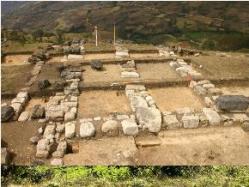 Pacopampa - A team led by Japanese archaeologist Yuji Seki has uncovered five tombs dating to 700-800 B.C. at the site of Pacopampa, in Cajamarca. The five tombs are believed to be linked to those five members of the Pacopampa culture who managed an ancient temple on the site. One of those tombs was of a young member of the site’s elite, though the gender of the remains has not yet been determined. Among the artifacts recovered in the 2,800-year-old tombs are gold lockets, pottery and stone beads, website Peruthisweek.com reported. Pacopampa was the site of the 2009 discovery of the so-called Lady of Pacopampa, who was found buried with various artifacts. In addition to the tombs and the temple walls which have been discovered on the site, monoliths, stele and pottery have been recovered at Pacopampa. Archaeologists believe that Pacopampa developed shortly after the Chavín culture, located in nearby Áncash. Exploration of the site is being carried in a project run jointly by San Marcos National University and the National Ethnographic Museum of Osaka, Japan.
Pacopampa - A team led by Japanese archaeologist Yuji Seki has uncovered five tombs dating to 700-800 B.C. at the site of Pacopampa, in Cajamarca. The five tombs are believed to be linked to those five members of the Pacopampa culture who managed an ancient temple on the site. One of those tombs was of a young member of the site’s elite, though the gender of the remains has not yet been determined. Among the artifacts recovered in the 2,800-year-old tombs are gold lockets, pottery and stone beads, website Peruthisweek.com reported. Pacopampa was the site of the 2009 discovery of the so-called Lady of Pacopampa, who was found buried with various artifacts. In addition to the tombs and the temple walls which have been discovered on the site, monoliths, stele and pottery have been recovered at Pacopampa. Archaeologists believe that Pacopampa developed shortly after the Chavín culture, located in nearby Áncash. Exploration of the site is being carried in a project run jointly by San Marcos National University and the National Ethnographic Museum of Osaka, Japan.
http://www.andina.com.pe/Ingles/noticia-archaeologists-find-2800yearold-tombs-in-pacopampa-cajamarca-430039.aspx
FRANCE – 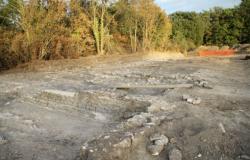 Bourg Charente - Les vestiges de ce qui pourrait être des villas gallo-romaines du début de notre ère ont été mis au jour sur le futur site de production de caviar . D'une superficie de 3,8 hectares, le terrain est situé sur la commune de Bourg-Charente. Les fouilles archéologiques ont débuté en juillet dernier et pourraient être prolongées de deux semaines, comme l'autorise la loi, pour que les équipes puissent venir à bout du chantier. Sur plusieurs dizaines de mètres carrés, des murs en pierres blanches remarquablement bien conservés sortent du sol. Il pourrait s'agir des fondations de deux villas gallo-romaines. Une information à prendre au conditionnel puisque les trouvailles quotidiennes des archéologues viennent sans cesse chambouler les premiers acquis. La découverte impressionne par son étendue. À quelques centaines de mètres de là, des tas de silex datant probablement du néandertal (entre 25 000 et 28 000 ans avant notre ère) auraient été également été mis au jour. Tout comme d'anciens silos à grains datant du Moyen Âge. Les archéologues restent pour l'instant discrets sur ces trouvailles, par peur des pillages. En juin 2010, lors du premier diagnostic, une sépulture datant du mésolithique (environ 10 500 ans avant notre ère) avait déjà été exhumée sur ce même site. Plus intéressant encore, le corps d'un homme avait été retrouvé, recroquevillé au fond de sa tombe.
Bourg Charente - Les vestiges de ce qui pourrait être des villas gallo-romaines du début de notre ère ont été mis au jour sur le futur site de production de caviar . D'une superficie de 3,8 hectares, le terrain est situé sur la commune de Bourg-Charente. Les fouilles archéologiques ont débuté en juillet dernier et pourraient être prolongées de deux semaines, comme l'autorise la loi, pour que les équipes puissent venir à bout du chantier. Sur plusieurs dizaines de mètres carrés, des murs en pierres blanches remarquablement bien conservés sortent du sol. Il pourrait s'agir des fondations de deux villas gallo-romaines. Une information à prendre au conditionnel puisque les trouvailles quotidiennes des archéologues viennent sans cesse chambouler les premiers acquis. La découverte impressionne par son étendue. À quelques centaines de mètres de là, des tas de silex datant probablement du néandertal (entre 25 000 et 28 000 ans avant notre ère) auraient été également été mis au jour. Tout comme d'anciens silos à grains datant du Moyen Âge. Les archéologues restent pour l'instant discrets sur ces trouvailles, par peur des pillages. En juin 2010, lors du premier diagnostic, une sépulture datant du mésolithique (environ 10 500 ans avant notre ère) avait déjà été exhumée sur ce même site. Plus intéressant encore, le corps d'un homme avait été retrouvé, recroquevillé au fond de sa tombe.
http://www.charentelibre.fr/2012/09/13/des-villas-gallo-romaines-sur-le-futur-elevage-d-esturgeons,1113972.php
CHINE –  Wanli - Archaeologists said a black substance found in an ancient tomb in northwest China's Shaanxi province is a 2,000-year-old portion of beef. Scientists arrived at the conclusion after months of analysis confirmed the substance's makeup, according to Hu Songmei, a paleontologist from the provincial archaeological institute. Xinhua news agency reports that according to Hu, the beef -- most of which had been carbonised -- is the earliest beef product discovered in China. The beef was discovered two years ago in a bronze pot placed in a tomb believed to date back to the Warring States Period (475 B.C. - 221 B.C.), said Hu.;The tomb was discovered during a excavation conducted by the institute from 2009 to 2010 in Wanli village in the provincial capital of Xi'an."The beef did not shrink, which proves that it had been dried before being put into the pot," said Hu. Bernama.
Wanli - Archaeologists said a black substance found in an ancient tomb in northwest China's Shaanxi province is a 2,000-year-old portion of beef. Scientists arrived at the conclusion after months of analysis confirmed the substance's makeup, according to Hu Songmei, a paleontologist from the provincial archaeological institute. Xinhua news agency reports that according to Hu, the beef -- most of which had been carbonised -- is the earliest beef product discovered in China. The beef was discovered two years ago in a bronze pot placed in a tomb believed to date back to the Warring States Period (475 B.C. - 221 B.C.), said Hu.;The tomb was discovered during a excavation conducted by the institute from 2009 to 2010 in Wanli village in the provincial capital of Xi'an."The beef did not shrink, which proves that it had been dried before being put into the pot," said Hu. Bernama.
http://www.nst.com.my/latest/archaeologists-find-2-000-year-old-beef-portion-in-ancient-tomb-in-northwest-china-1.150100#
USA – 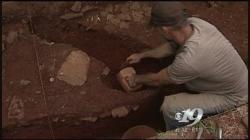 Monticello - Archaeologists at Monticello are uncovering a road that hasn't been seen this century, and for the next eight weeks, they'll be digging for Jefferson-era artifacts. From a large piece of a pig's jaw bone to cobblestones, Monticello's Kitchen Road is coming back alive. For a total of 10 weeks, Monticello's archaeological team is digging down to find the road servants used to access the main house. "It was also the road along which all the food and heavy stuff came to the kitchen," Neiman said. The archaeological team says they're just now digging deep enough to reach items from Jefferson's time, but they've already found some interesting artifacts along the way. One item in particular is of special importance to the crew. "A 1923 dime," Neiman said. "[It's] is a big year because it's the year that the Thomas Jefferson Foundation bought Monticello." The dig is on display for guests to watch and learn how the process works and also what the road
Monticello - Archaeologists at Monticello are uncovering a road that hasn't been seen this century, and for the next eight weeks, they'll be digging for Jefferson-era artifacts. From a large piece of a pig's jaw bone to cobblestones, Monticello's Kitchen Road is coming back alive. For a total of 10 weeks, Monticello's archaeological team is digging down to find the road servants used to access the main house. "It was also the road along which all the food and heavy stuff came to the kitchen," Neiman said. The archaeological team says they're just now digging deep enough to reach items from Jefferson's time, but they've already found some interesting artifacts along the way. One item in particular is of special importance to the crew. "A 1923 dime," Neiman said. "[It's] is a big year because it's the year that the Thomas Jefferson Foundation bought Monticello." The dig is on display for guests to watch and learn how the process works and also what the road
VIDEO = http://www.newsplex.com/home/headlines/Monticello-Crews-Unearth-History-on-Archaeological-Dig-172184251.html
BULGARIE – 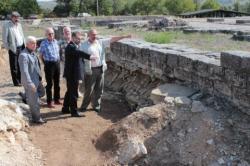 Shumen - Bulgaria's Finance Minister Simeon Djankov has promised to provide funding for four archaeological reserves in the northeastern Shumen District. Djankov visited Monday the site of Veliki Preslav, the capital of the First Bulgarian Empire in 893-971 AD. He said he could allocate about BGN 180 000 from Bulgaria's state budget for the territorial organization plans of the archaeological sites around Shumen that are related to the history of the First Bulgarian Empire. "For the time being, we are presenting only a small part – about 5% of Pliska (the first capital of the First Bulgarian Empire in 681-893 AD – editor's note), and about 15% from Veliki Preslav. The rest hasn't been developed. I think we need to take the next big step so that if you are a tourist from Germany or England, we can tell you exactly what we want to show you. These people are probably not that interested in the fact that Bulgaria originated here," the Deputy PM elaborated. "These people want to see something that is connected to them – knights or some kind of a script, or some secret passages. I think the good story about Pliska and Veliki Preslav hasn't reached the level at which we can tell it to a non-Slavic European yet," Djankov added.:He did stress that the future construction of the northern Hemus Highway between Sofia and Varna will help boost cultural and historical tourism in the Shumen District.
Shumen - Bulgaria's Finance Minister Simeon Djankov has promised to provide funding for four archaeological reserves in the northeastern Shumen District. Djankov visited Monday the site of Veliki Preslav, the capital of the First Bulgarian Empire in 893-971 AD. He said he could allocate about BGN 180 000 from Bulgaria's state budget for the territorial organization plans of the archaeological sites around Shumen that are related to the history of the First Bulgarian Empire. "For the time being, we are presenting only a small part – about 5% of Pliska (the first capital of the First Bulgarian Empire in 681-893 AD – editor's note), and about 15% from Veliki Preslav. The rest hasn't been developed. I think we need to take the next big step so that if you are a tourist from Germany or England, we can tell you exactly what we want to show you. These people are probably not that interested in the fact that Bulgaria originated here," the Deputy PM elaborated. "These people want to see something that is connected to them – knights or some kind of a script, or some secret passages. I think the good story about Pliska and Veliki Preslav hasn't reached the level at which we can tell it to a non-Slavic European yet," Djankov added.:He did stress that the future construction of the northern Hemus Highway between Sofia and Varna will help boost cultural and historical tourism in the Shumen District.
http://www.novinite.com/view_news.php?id=143723
FRANCE –  Cahors - Des sondages archéologiques ont été effectués place Bergon dans le cadre du chantier du Trait d'Union. Bilan : des murs des XVIIe-XVIIIe siècles à l'Antiquité. Du mercredi 12 septembre à ce lundi, la cellule départementale d'archéologie a mené là des sondages archéologiques. Laurent Guyard en est le responsable. il s'agit de travaux de surface : 1,40 mètre au plus profond, pour le canal. «Mais on a des vestiges hauts», dit l'archéologue en montrant un mur antique à 1,20 mètre de profondeur, «ce serait dommage de détruire une mosaïque encore en place». Pas de monuments antiques ici mais des témoignages de plusieurs siècles de vie cadurcienne : des murs et une canalisation modernes (des XVIIe et XVIIIe siècles) qui pourraient provenir de l'hôpital, ainsi que des murs antiques. Les archéologues ont aussi trouvé quantité de tesselles, les petites pierres qui forment les mosaïques. «Ce devait être un quartier résidentiel avec des maisons à mosaïques», dit l'archéologue. Mais les hasards du sondage n'ont pas permis de tomber sur un tel «trésor». Entre les couches antiques et modernes, une épaisseur de terre végétale. «La ville romaine était très importante ; elle occupait toute la boucle du Lot», dit Laurent Guyard, «elle a été désertée au IIIe siècle et la ville s'est resserrée sur la frange étroite fortifiée au VIe siècle». Cahors a repris l'espace à l'époque moderne.
Cahors - Des sondages archéologiques ont été effectués place Bergon dans le cadre du chantier du Trait d'Union. Bilan : des murs des XVIIe-XVIIIe siècles à l'Antiquité. Du mercredi 12 septembre à ce lundi, la cellule départementale d'archéologie a mené là des sondages archéologiques. Laurent Guyard en est le responsable. il s'agit de travaux de surface : 1,40 mètre au plus profond, pour le canal. «Mais on a des vestiges hauts», dit l'archéologue en montrant un mur antique à 1,20 mètre de profondeur, «ce serait dommage de détruire une mosaïque encore en place». Pas de monuments antiques ici mais des témoignages de plusieurs siècles de vie cadurcienne : des murs et une canalisation modernes (des XVIIe et XVIIIe siècles) qui pourraient provenir de l'hôpital, ainsi que des murs antiques. Les archéologues ont aussi trouvé quantité de tesselles, les petites pierres qui forment les mosaïques. «Ce devait être un quartier résidentiel avec des maisons à mosaïques», dit l'archéologue. Mais les hasards du sondage n'ont pas permis de tomber sur un tel «trésor». Entre les couches antiques et modernes, une épaisseur de terre végétale. «La ville romaine était très importante ; elle occupait toute la boucle du Lot», dit Laurent Guyard, «elle a été désertée au IIIe siècle et la ville s'est resserrée sur la frange étroite fortifiée au VIe siècle». Cahors a repris l'espace à l'époque moderne.
http://www.ladepeche.fr/article/2012/09/26/1449432-cahors-sous-la-place-bergon-pres-de-2000-ans-d-histoire.html
LA REUNION – 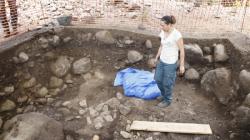 Lazaret - C’est une page essentielle de l’histoire de La Réunion qui s’est jouée ici car beaucoup de nos ancêtres ont séjourné dans ce lieu de quarantaine. L’étude archéologique du cimetière permettra de documenter l’ensemble funéraire sur son emprise, son organisation, et la population qu’il représente. Si l’état de conservation des ossements le permet, des analyses anthropologiques poussées sur les ossements pourraient être effectuées afin d’informer sur l’âge, le sexe, les conditions de vie, les pathologies, les pratiques funéraires, et l’origine géographique et sociale des défunts. Pour sa part, Catherine Chane-Kune, directrice du service culture et sports au conseil général, a indiqué : "A travers le chantier du Lazaret 2, ce sont les archives du sol qui sont explorées afin d’enrichir encore plus la connaissance du peuplement de La Réunion. Ces recherches sont connues dans la zone océan Indien et il sera possible d’écrire collectivement l’histoire des émigrés du 19ème siècle". Les fouilles se termineront fin octobre. Le premier rapport scientifique sera remis au cours du premier semestre 2013.
Lazaret - C’est une page essentielle de l’histoire de La Réunion qui s’est jouée ici car beaucoup de nos ancêtres ont séjourné dans ce lieu de quarantaine. L’étude archéologique du cimetière permettra de documenter l’ensemble funéraire sur son emprise, son organisation, et la population qu’il représente. Si l’état de conservation des ossements le permet, des analyses anthropologiques poussées sur les ossements pourraient être effectuées afin d’informer sur l’âge, le sexe, les conditions de vie, les pathologies, les pratiques funéraires, et l’origine géographique et sociale des défunts. Pour sa part, Catherine Chane-Kune, directrice du service culture et sports au conseil général, a indiqué : "A travers le chantier du Lazaret 2, ce sont les archives du sol qui sont explorées afin d’enrichir encore plus la connaissance du peuplement de La Réunion. Ces recherches sont connues dans la zone océan Indien et il sera possible d’écrire collectivement l’histoire des émigrés du 19ème siècle". Les fouilles se termineront fin octobre. Le premier rapport scientifique sera remis au cours du premier semestre 2013.
http://www.ipreunion.com/actualites/reportage/2012/09/28/conseil-general-grande-chaloupe-des-fouilles-archeologiques-pour-decouvrir-les-secrets-du-lazaret,17368.html